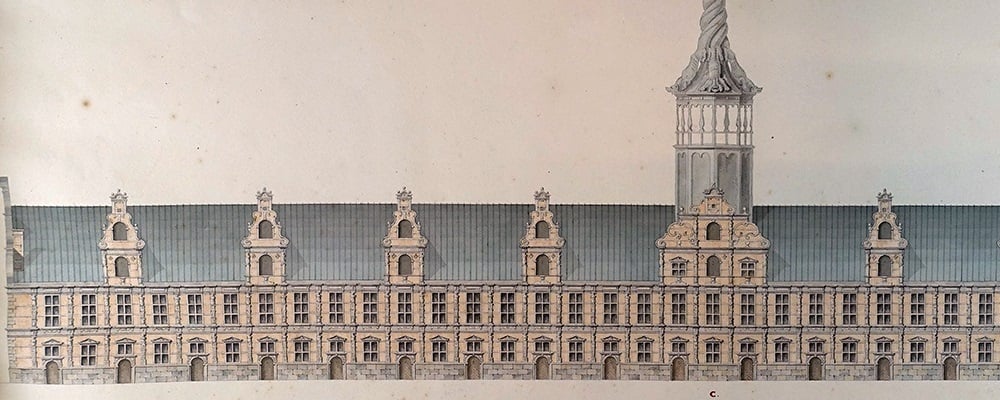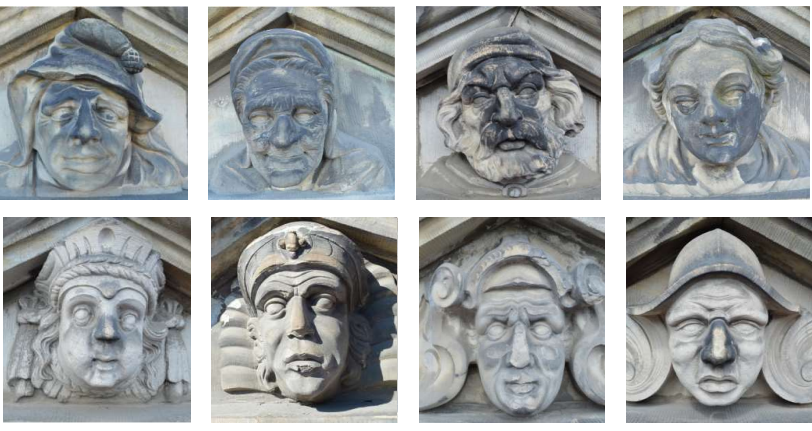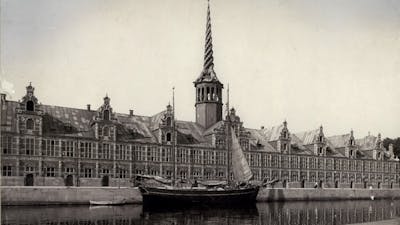
Architecture
The History of the Building
Børsen has had a changeable existence — from a motley bazaar to a financial centre with some of the city’s finest meeting rooms and offices. The building has been rebuilt and restored many times, but is still one of the best examples of Renaissance architecture. Børsen’s interior in particular has changed appearance and furnishings repeatedly during its 400-year history.
It Began with an Embankment
In 1620, construction was begun of a long building on an embankment facing the Christianshavn quarter. Peasants from the town of Roskilde and Copenhagen’s surrounding area were ordered to drive in four wagon loads of boulders for the embankment’s foundations. The construction work was led by master builder Hans Steenwinckel, and the building’s architecture was inspired by Dutch Renaissance architecture, with sandstone bands and stone figures. Timber and sandstone came from Gotland, and the bricks from Holland.
The King Was the Master of Details
Christian IV followed the building work intently; from the windows of Copenhagen Castle (where Christiansborg lies today) he could follow it at close quarters. But the king wasn’t satisfied with what he saw. The building looked more like a storeroom than a royal building. Christian IV therefore ordered the building of the impressive, sweeping western gable with its rich decoration. In 1625 the twined Dragon’s tail spire rose above the city, after which the roof and façades were adorned with ornamental gables and mansards facing the water.

Hermer og Karyatider
Børsen er udsmykket med 486 forskellige sandstensfigurer – hermer og karyatider, maskefigurer og fordakningshoveder.
Nutidige kunsthistorikere har ivrigt diskuteret den symbolske betydning af den specielle udsmykning. Man har foreslået af hermerne var en del af renæssancens okkulte hermetiske symbolik, eller at hermerne skulle knytte bygningens til den antikke gud Hermes (eller Merkur), som var købmændenes, de handlendes og tyvenes gud.
Uanset betydningen og symbolikken, virker som om, at datidens håndværkere fik en stor grad af kunstnerisk frihed ved udformningen af hermer og karyatiderne. Nogle af figurerne fik glade ansigtsudtryk, andre sørgmodige, vrede og eftertænksomme. Figurerne blev iklædt eksotiske og fremmede klædedragter der gav associationer til fremmede lande og byer, mens flere karyatider blev humoristisk, betænksomt udhugget med bløde puder på hovedet, for at lette trykket fra den tunge vægt fra gesimser og murværk.

All the heads, masks, Herms and Caryatids on Børsen are different. But there are groups with various characteristic expressions. There is, for example, a difference between the original heads from 1624 and those which have since been replaced and reinterpreted in various styles. There are in all 204 Herms and Caryatid figures, 120 masked figures and 162 cornice figures.
-
1619
Construction of Børsen begins
-
1624
Børsen is completed and opens for trade.
-
1625
Børsen gains the Dragon Spire.
-
1640
Børsen’s eastern gable facing Christianshavn is completed.
-
1658-1660
Parts of Børsen’s lead roof are removed and used to cast musket balls during the Swedish siege of Copenhagen
-
1756
The roof was leaking. Copper was too expensive, so sheet metal was used instead.
-
1775 Spire or Dome?
Børsen was dilapidated, and Christian VII granted funds for an extensive restoration. There were wild plans for replacing the heavy Dragon Spire with a dome. But the spire was preserved.
-
1816 Building in Disrepair
Architect CB Hornbech furnished a new auction room in the classical style, in extension of Børssalen, the stock exchange hall, to the west.
-
1857 Denmark’s First Protected Building
Grosserer-Societetet, the Society of Wholesale Merchants, bought Børsen from Frederick VII for 70,000 rigsdaler, or rix-dollars. A condition of the sale was that the new owners must preserve the building’s “curious appearance”, and all future changes required the king’s approval.
-
1879 New Materials
Børsen was once again in a bad state, and extensive restoration was required. The building gained a new copper roof, and the façade was pointed up with a thin cladding.
-
1942-1945 A Cigar Box
The famous Danish architect Kaj Gottlob is refurbishing the Børsgangen on the first floor so that it has the look it has today.
-
1957
On the occasion of 100 years of ownership by Grosserer-Societetet, the young artist Boye Givskov made the large mosaic on the ground floor. The mosaic relates the history of Børsen and of trade in Denmark.
-
2022-
A very extensive restoration of the façades and roof is begun. The restoration is to result in the façade being returned to its original Renaissance style, the restoration of 482 sandstone figures, and an entirely new copper roof.
-
2024
On 16 April 2024 approximately half of the building, Børssalen, the Library, the iconic spire and a number of offices on the ground floor, burned down completely.
-
Rebuilding
Immediately after the fire the decision was taken to rebuild Børsen. This means that Børssalen, the Library and the Dragon Spire will be rebuilt. The planned restoration of the exterior will be completed.
The Reconstruction of Børsen

Architecture
Børsen has had a changeable existence — from a motley bazaar to a financial centre with some of the city’s finest meeting rooms and offices. The building has been rebuilt and restored many times.

The King's Vision for Børsen
Christian IV was an enterprising king, and was very interested in the 17th century’s new economic ideas about growth and wealth through international trade. Copenhagen therefore needed to have a stock exchange, where buyers and sellers could meet for mutual profit and gain.

Fire and reconstruction
At 7.36 am on 16 April 2024 the alarm centre received a report of a fire at Børsen. For 400 years fire in the old stock exchange building had been avoided. The city has burned down around Børsen twice.